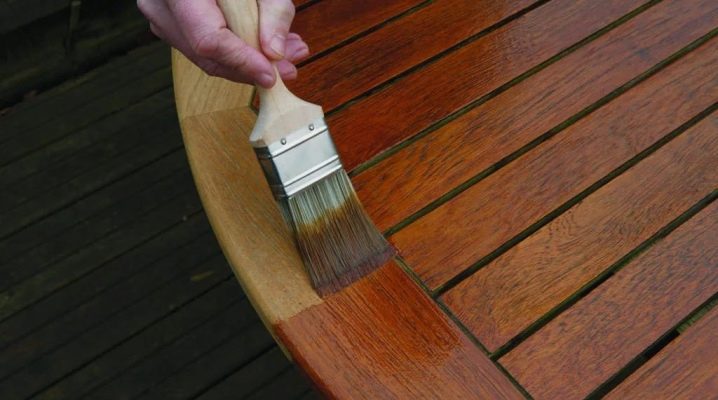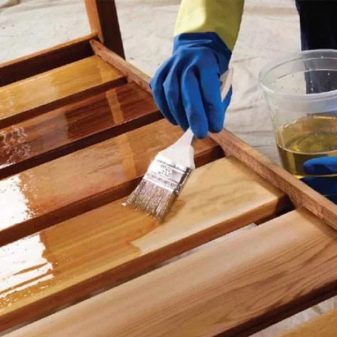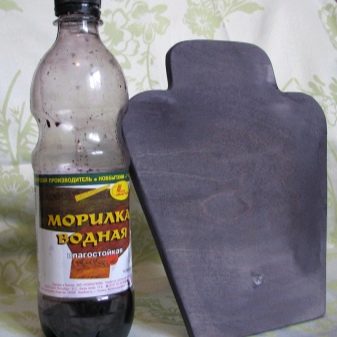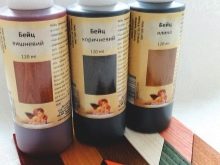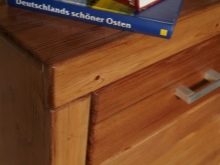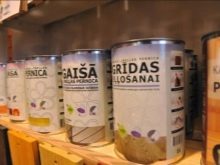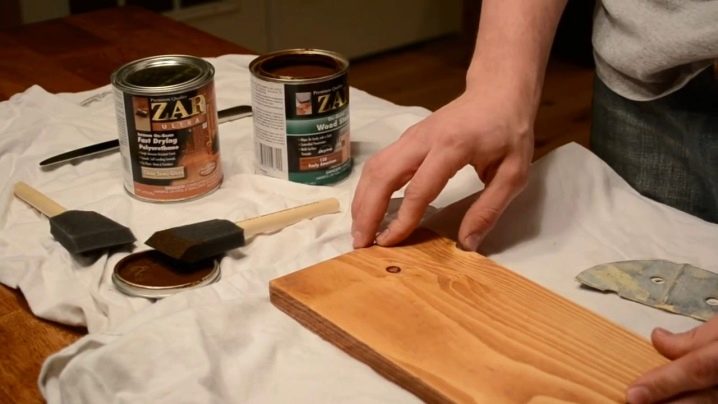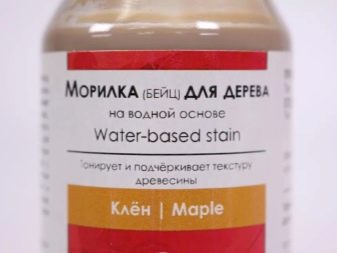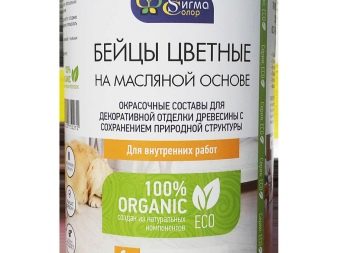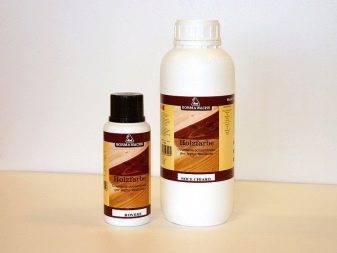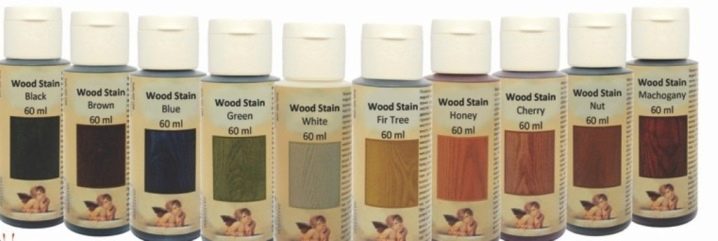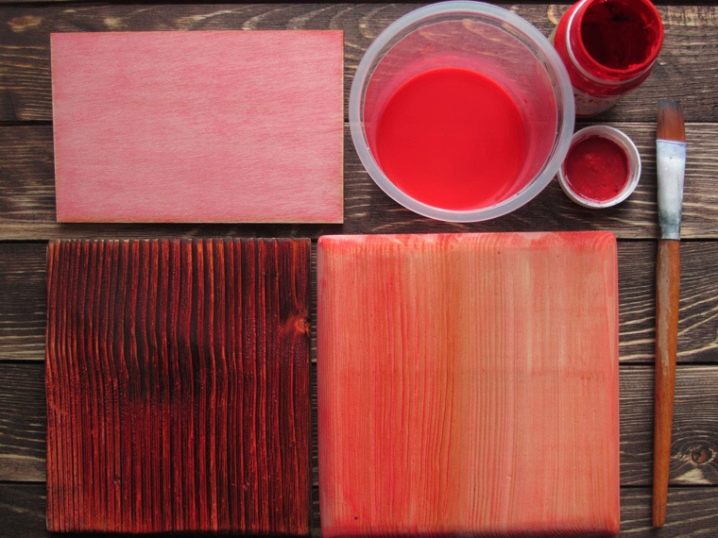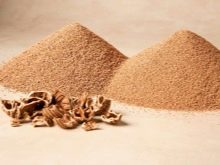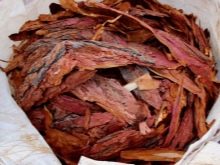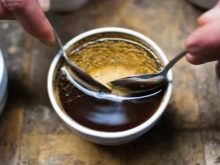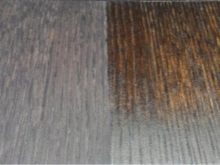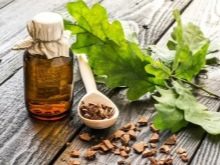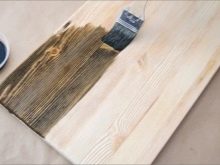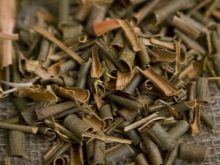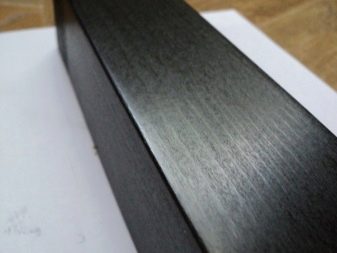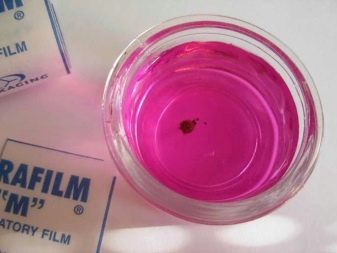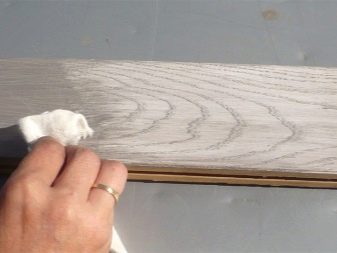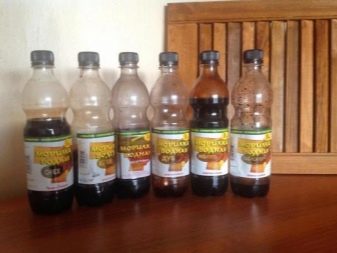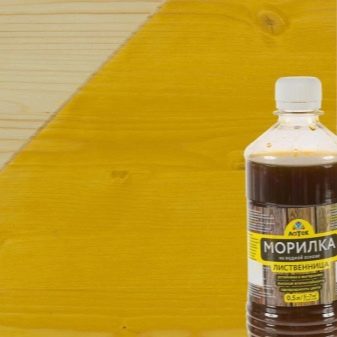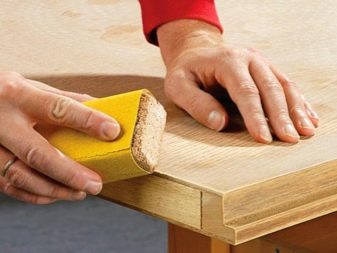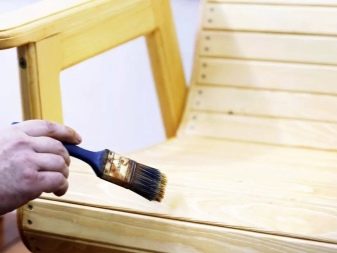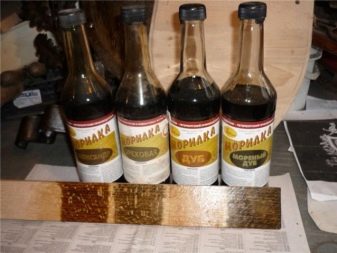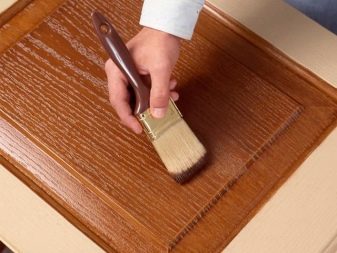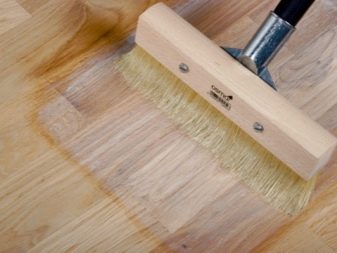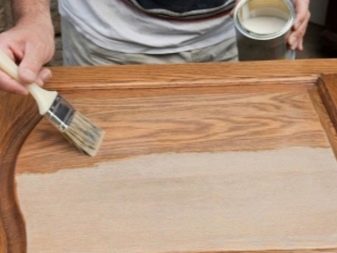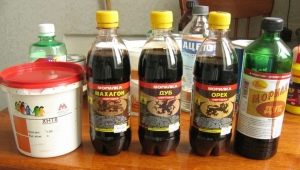Features of the water stain
Wood stain is a means for tinting wood, which penetrates deep into the material, gives shade and preserves the natural pattern of fibers.
A water stain protects the tree from damage by fungus and insects, thereby prolonging its life.
Special features
Base is different from varnishes and paints in that it does not form a surface layer. The pigment penetrates the material, so it is not afraid of scratches and chips, while maintaining the natural structure of the tree.
The buck is of two kinds. The first group is water-soluble - it can be sold in ready-made solution or in powder form. Water stains are safe - they can safely handle children's furniture. They do not have a sharp unpleasant odor, penetrate deep into the texture of wood, have a low price and can be made independently.
Wood treated with wood stain has the following qualities:
- increases the resistance of the surface to abrasion;
- the surface is less susceptible to mold;
- decreases the porosity of the material, which additionally protects against moisture.
The density of color depends on the number of layers. A water-based stain during painting lifts the outer fibers of the wood, therefore after that, mandatory grinding is required. If woodwork is outdoors, then For additional protection, it is recommended to cover with a transparent varnish on top..
Subspecies of water stain is an acrylic version, which is an emulsion. It has a wider selection of colors and is resistant to fading in the sun. Also the price difference is significant: acrylic is 6-7 times more expensive.
Non-aqueous beins include alcohol, oil and wax. Alcohol options are made on the basis of aniline dye. They have a high drying rate, but can leave stains. Oil batts are sold as a powder diluted with solvent. They dry rather quickly, thanks to an oil base they allow to mix different dyes,which is often used in decorating.
Wax materials create a protective layer, but do not penetrate deep into the structure. After their use, the surface should not be varnished or treated with polyurethane.
Colors
Water-based weave has an extensive color palette of shades imitating all types of wood: from light beige to black. If you need another color, for example, green, then you need to look for it among non-aqueous stains.. To create a saturated hue, it is necessary to apply several layers or to add more dry constituent when preparing the solution.
All manufacturers accompany the production of specimens of stain. When buying, you can easily choose the right tone. However, it is important to know that the same color will look different on different types of wood. For example, the shade indicated on the sample, which is often a pine tree, will be darker on oak or poplar furniture and reddish on mahogany, but it will hardly change on maple, since the material is rather dense.
Sami stain can be mixed to give an individual shade. For unusual effects, the main tone is first applied, then with different strokes - a stain of a different color.
Wood stain can be made independently.The combination of various natural ingredients gives certain shades. Changes in proportion leads to a change in shade.
The red color of the stain will give a decoction of the following ingredients:
- larch bark;
- onion peel (shade closer to orange);
- crushed walnut shells with the addition of a solution of potassium dichromate.
Brown and mocha color is obtained during the preparation process:
- Broth bark in equal proportions of willow and oak with the addition of alder earrings. Brown saturation will give crushed walnut shells.
- A decoction of shells of walnut and bark.
- Strongly brewed natural coffee.
- Brewed black tea, the strength of which affects the color.
Black and ebony color can be obtained with:
- decoction of oak and alder bark;
- decoction of the bark of willow and alder.
The color of black ebony will give a solution of iron corrosion - for this, small pieces of iron need to be filled with vinegar and left to stand in a dark place for two days. Black color can be obtained if you insist on them much more, but not more than a week.
Gray color is obtained if, after staining with a decoction of walnut, to wipe the surface with vinegar.If you boil the unripe buckthorn fruit, you get a yellow shade stain.
The color of the cherry will give a solution of potassium permanganate - this requires diluting 25 g of manganese in 0.5 liters of water. After treatment, the surface should be immediately wiped with a soft, hygroscopic cloth.. To obtain a rich shade should be applied several layers.
It looks interesting white wood furniture. Instead of staining, it can be bleached with a stain, for which better to buy ready-made white composition from the manufacturer. Most often it is found on an oil basis, but can also be found on water. Wood stain clogs pores, thereby lightening wood, while not painting the picture itself.
Manufacturers
Among the well-known brands of bain can be distinguished "Novbythim", "Latek" and Trae Lyx. Petersburg products Novbythim company has a wide palette of shades that blend perfectly with each other. Wood stains are inexpensive for the price, odorless, easily removed from the skin of hands and soiled surfaces. Quickly absorbed, making it easy to achieve a uniform layer. Used exclusively for interior work.
Consumers note fast wiping and color fading.The moisture resistance declared by the manufacturer, unfortunately, is not true - spilled water or drops leave ugly light spots. But all the flaws in the process are easily erased. The colors are translucent, therefore for a good saturated shade it is required to apply many layers.
Against this background, the water stains of another Russian the company "Latek" look better They improve the durability of wood, thereby increasing the life. After applying the stain, a special vapor-permeable film is formed on the surface. Among the shortcomings, users note a significant difference in the color of the stain on the test sample from the result.
Swedish stains Trae Lyx do not form stains when applied and allow you to tint previously painted surfaces. They are perfectly mixed together. Among the palette of shades can be found white Stake on a water basis.
Tips
It is easier to work with wood stain than with paint, but here you can make smudges and stains. If the tree has any defects or smeared cracks, then such defects will become well visible.
The algorithm for applying the stain:
- The surface must be clean.If there is any wood tar or oil stains, they should be sanded and degreased.
- Some woods absorb moisture well. To reduce the consumption of stain, you can pre-moisten the surface. This technique will also reduce hairiness after staining.
- Baits need to shake or mix thoroughly. If the diluted composition turned out to be cloudy, then it should be filtered through a thick cloth or cotton wool filter.
- Apply the stain can be a brush, foam rubber, roller, spray or cotton swab. Need to starve along the fibers. If you "pour" a lot of liquid, then ugly smudges can remain. When painting a vertical surface, it should be applied from top to bottom.
- If there are several layers, each subsequent layer should be applied after the previous one dries (after 4-12 hours). The finish layer dries up to 24 hours.
If a large hairiness is formed on the surface, then it can be polished. The surface must be dry.
When it is necessary to process a large area, you can first use a cheaper composition, and for the finishing layer to acquire a better quality stain, thus saving on price.
If stains and smudges form, they should be washed out with water or carefully wiped off with acetone.. In some cases, only polishing will help. After that you should apply 1-2 more layers of stain.
When the product is made of different wood species, then after staining the areas may differ in color, even if initially there were no differences in it. This must be taken into account, otherwise you can spoil the product. In some cases, instead of the stain, it is better to use paint or varnish.
Acquired shade may differ from the sample when applied. To predict the result, you need to apply the stain on the bar similar to wood, and at the same time to find the desired shade and determine the number of layers. If there is no bar, it can be applied to the area where it will not be visible. For example, when working with a wooden chair, you can use a seat under the seat or the inside of the leg. Unsuccessfully selected color can always be corrected with a darker shade.
For more details on how to work with water stain, see below.
